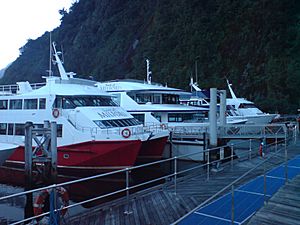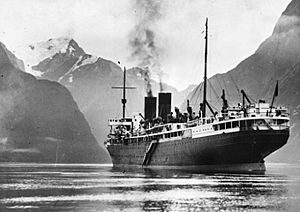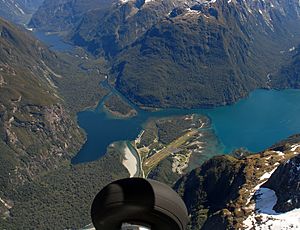Transport in Milford Sound facts for kids
Milford Sound is a super popular place in New Zealand's South Island. It's a beautiful fiord, which is like a long, narrow sea inlet with steep cliffs. Lots of people want to visit, but getting there can be tricky because it's in a very remote area. Most visitors come and go within a few hours each day because there aren't many places to stay. This means everyone arrives at the same time, especially around noon, making it very busy. The drive to Milford Sound from Te Anau is known as one of the most scenic drives in the world!
Over the years, people have suggested different ways to make it easier to get to Milford Sound. These ideas include building new tunnels, a special monorail, or even a gondola lift. The goal is to help more people visit without harming the environment or making the experience less enjoyable.
Contents
Getting to Milford Sound
Why is Milford Sound Hard to Reach?
A Hidden Gem
Milford Sound is a fiord located in the southwest part of New Zealand's South Island. It's in a region called Fiordland, which is very remote and has very few people living there. High mountains called the Southern Alps separate it from other towns. The only way in, besides a challenging mountain road, is a narrow channel from the Tasman Sea. Even famous explorer Captain Cook didn't go into Milford Sound in 1769 because he thought the entrance looked too dangerous and didn't realize how big the water body behind it was.
Old Ways to Communicate
The first post office in Milford Sound was on a tiny island! People would hang a rum barrel on a tree to post mail and raise a white flag to show there was mail to be sent. Passing ships would then stop, check the mail, and take any letters addressed to places they were going.
A Popular Place with Challenges
Milford Sound is incredibly beautiful and attracts many tourists, even though it's so remote. Over 550,000 people visit each year! Most tourists only come for a day trip because there isn't much accommodation inside Fiordland National Park. About 80% of visitors return to Te Anau or Queenstown in the late afternoon, which can be a 12-hour round trip from Queenstown. This means that the tourist boats at Milford Sound are very busy for only a few hours around lunchtime.
Because it's so popular but hard to reach, many ideas have been suggested to improve how people get to Milford Sound. The goal is to increase tourism while still protecting this amazing natural treasure.
How People Travel There Now
Driving the Milford Road
Most tourists arrive by bus or car on Milford Road (State Highway 94). This is a high mountain road that can be dangerous, especially in winter, because of avalanches. The road only opened in 1953 after the Homer Tunnel was finished. It's one of New Zealand's more dangerous public roads, with more crashes than average.
Stopping is not allowed in many parts of the road due to the risk of rocks or snow falling. The road often closes in winter, and you must carry snow chains if there's snow. Helicopters are even used to drop explosives to cause controlled avalanches and make the road safer. Even with these efforts, there's still a small risk, especially near the Homer Tunnel.
Drivers are told to start their trip from Te Anau with a full tank of gas, as there are very few places to refuel later. Despite these challenges, up to 50 buses and hundreds of private cars travel this road daily.
The road has some limitations, like areas without passing lanes, one-lane bridges, and a narrow width. The Homer Tunnel is a one-way route controlled by traffic lights during busy summer times because it's not wide enough for two buses to pass each other. Plans are being made to improve the road and the tunnel, but widening the tunnel would be very expensive.
In the 2010s, new electronic signs were put up to tell drivers about road conditions and closures. These signs use satellite links, which saved a lot of money because they didn't need expensive communication cables. The signs are powered by small hydro-power systems with battery backups.
Boats and Ships
A small number of tourists arrive by larger ships, like cruise ships, that visit Milford Sound as part of their journey. Some private yachts also come, but not many vessels travel along this rugged coastline anymore.
Flying In
Many tourists also arrive by small planes or helicopters, or they fly over the Sound as part of their trip. Milford Sound Airport had about 16,000 aircraft movements in 2004, mostly flights to and from Queenstown. To reduce noise, the Department of Conservation has encouraged bigger, quieter aircraft. In 2007, rules were put in place to limit the number of flights in the Fiordland area.
Walking the Milford Track
One main walking path leads into Milford Sound from the east, called the Milford Track. This 53 km track starts near Lake Te Anau and takes four days to complete. It goes over a mountain pass and through areas that can flood. To protect the natural landscape, only a limited number of walkers are allowed on the track each day, and they must stay in specific huts each night. Spots on the track are usually booked many months in advance.
Ideas to Make Travel Better
Sharing Buses
In winter, even when the road is open, many buses travel to Milford Sound almost empty. People have suggested that tour companies should share their buses to be more efficient.
Park and Ride System
One idea was to create a "park and ride" system, where visitors would leave their cars at a place like Te Anau and take a shuttle bus to Milford Sound. This would help reduce traffic jams. However, this idea was not popular because it would limit tourists' freedom and add more travel time to an already long journey. It also takes away the right to drive there freely, so it's unlikely to happen.
Other Ideas for Existing Travel
Other ideas included making Milford Sound Airport bigger for larger planes, but this was thought to be too noisy and expensive for tourists. Limiting access to only approved bus companies, or charging tolls on Milford Road, were also considered. All these ideas would make visiting Milford Sound more complicated and costly, so they haven't moved forward.
New Ways People Have Suggested
The Haast-Hollyford Highway Idea
The Haast-Hollyford Highway is a long-standing idea, first suggested in the 1880s. It would connect Haast, a town north of Milford Sound, through the Hollyford Valley to Milford Sound and Te Anau. This would allow for a multi-day round trip, for example, from Queenstown to Milford Sound and then to Haast before returning to Queenstown.
However, building about 120 km of new road in a remote area would be very expensive (estimated at NZ$165–275 million). There are also concerns about building a new road through Fiordland National Park and how it might increase traffic on the existing road to Milford Sound. Environmental groups have strongly opposed this plan. Despite this, some local leaders and business people continue to support the idea, believing it would boost tourism.
Big Ideas That Didn't Happen
The Fiordland Link Experience (Monorail)
This idea wanted to combine different ways of travel to cut down the trip time to Milford Sound by about an hour. Travelers would take catamarans (fast boats) across Lake Wakatipu. Then, they would ride special all-terrain buses up a mountain road. After that, they would switch to a mechanical monorail that would travel for 41 km through the countryside and native bush. This would have been the longest monorail in the world!
The monorail would connect to the existing road to Milford Sound. This project was estimated to cost up to NZ$132 million. Its supporters believed it would be good for the environment because it wouldn't go through National Parks and would use small foundations for the monorail tracks. However, in 2014, the New Zealand Conservation Minister rejected the plan, saying it wasn't good enough economically or environmentally.
The Milford Dart Tunnel
This idea involved building a new tunnel and using special guided buses to create a much shorter route from Queenstown to Milford Sound, avoiding the long detour through Te Anau. The plan was to build an 11.3 km tunnel through the mountains, connecting existing roads. This would cut travel distance from 304 km to just 125 km, reducing travel time from 5.5 hours to 2 hours.
Inside the tunnel, buses would use special technology to guide them, allowing the tunnel to be narrower and cheaper to build. This project was estimated to cost around NZ$150 million. However, there were many concerns. Both ends of the proposed tunnel would be in National Parks (Fiordland National Park and Mount Aspiring National Park), where building new roads is usually not allowed. Getting rid of a huge amount of excavated soil from the tunnel was also a problem. Businesses in Te Anau were worried that tourists would bypass their town.
In 2013, the Minister for the Environment rejected the tunnel application. The reasons included the issue of disposing of half a million tonnes of tunnel spoil, the impact of new roads and tunnel entrances on the National Parks and the famous Routeburn Track, and that the project didn't fit with the National Park management plan. The minister also had doubts about whether the project would make enough money.
The Sky Trail Gondola
Another idea, proposed around 2001, was to build a gondola lift between the Caples Valley and the Hollyford Valley. This project would have cost about NZ$100–110 million and would have been 12.6 km long, making it the longest gondola ride in the Southern Hemisphere. It was designed to carry 900 passengers per hour and would have cut the 12-hour round trip by about 3 hours.
However, the Department of Conservation refused permission for this project because of its expected impact on the untouched wilderness it would cross. Critics were concerned about destroying beech forests for 85 towers and two transfer stations, increased bus traffic on quiet roads, and the gondola spoiling the natural views. There were also worries about building it in an area with strong earthquakes and winds.
Other Tunnel Ideas
Other ideas considered included a new one-way route from Queenstown to Milford Sound through a tunnel in the Darran Mountains. This would have cut the trip time significantly. However, this plan also faced major difficulties because it involved building new structures in two National Parks, so it didn't move forward.
|






